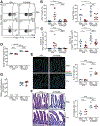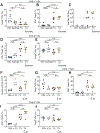The gut protist Tritrichomonas arnold restrains virus-mediated loss of oral tolerance by modulating dietary antigen-presenting dendritic cells
- PMID: 37478853
- PMCID: PMC10529081
- DOI: 10.1016/j.immuni.2023.06.022
The gut protist Tritrichomonas arnold restrains virus-mediated loss of oral tolerance by modulating dietary antigen-presenting dendritic cells
Abstract
Loss of oral tolerance (LOT) to gluten, driven by dendritic cell (DC) priming of gluten-specific T helper 1 (Th1) cell immune responses, is a hallmark of celiac disease (CeD) and can be triggered by enteric viral infections. Whether certain commensals can moderate virus-mediated LOT remains elusive. Here, using a mouse model of virus-mediated LOT, we discovered that the gut-colonizing protist Tritrichomonas (T.) arnold promotes oral tolerance and protects against reovirus- and murine norovirus-mediated LOT, independent of the microbiota. Protection was not attributable to antiviral host responses or T. arnold-mediated innate type 2 immunity. Mechanistically, T. arnold directly restrained the proinflammatory program in dietary antigen-presenting DCs, subsequently limiting Th1 and promoting regulatory T cell responses. Finally, analysis of fecal microbiomes showed that T. arnold-related Parabasalid strains are underrepresented in human CeD patients. Altogether, these findings will motivate further exploration of oral-tolerance-promoting protists in CeD and other immune-mediated food sensitivities.
Keywords: T helper 1; Tritrichomonas; celiac disease; dendritic cells; dietary antigen; loss of oral tolerance; microbiota; oral tolerance; regulatory T cell; reovirus.
Copyright © 2023 Elsevier Inc. All rights reserved.
Conflict of interest statement
Declaration of interests E.F.V. is a member of the Biocodex International and National (Canada) Scientific Review Boards, a member of the Center for Gut Microbiome Research and Education Scientific Advisory Board of the AGA, Secretary of the International Society of the Study of Celiac Disease, and holds grants from Kallyope and Codexis, unrelated to this study. H.J.G. holds a grant from Codexis, unrelated to this study.
Figures






References
Publication types
MeSH terms
Substances
Grants and funding
- R21 AI163721/AI/NIAID NIH HHS/United States
- T32 AI060525/AI/NIAID NIH HHS/United States
- T32 GM150375/GM/NIGMS NIH HHS/United States
- R21 CA259636/CA/NCI NIH HHS/United States
- R01 AI168478/AI/NIAID NIH HHS/United States
- R25 GM086262/GM/NIGMS NIH HHS/United States
- R01 DK130897/DK/NIDDK NIH HHS/United States
- R01 DK098435/DK/NIDDK NIH HHS/United States
- N01 AI030055/AI/NIAID NIH HHS/United States
- S10 OD023402/OD/NIH HHS/United States
- T32 AI089443/AI/NIAID NIH HHS/United States
- R01 AI130055/AI/NIAID NIH HHS/United States
LinkOut - more resources
Full Text Sources
Molecular Biology Databases

